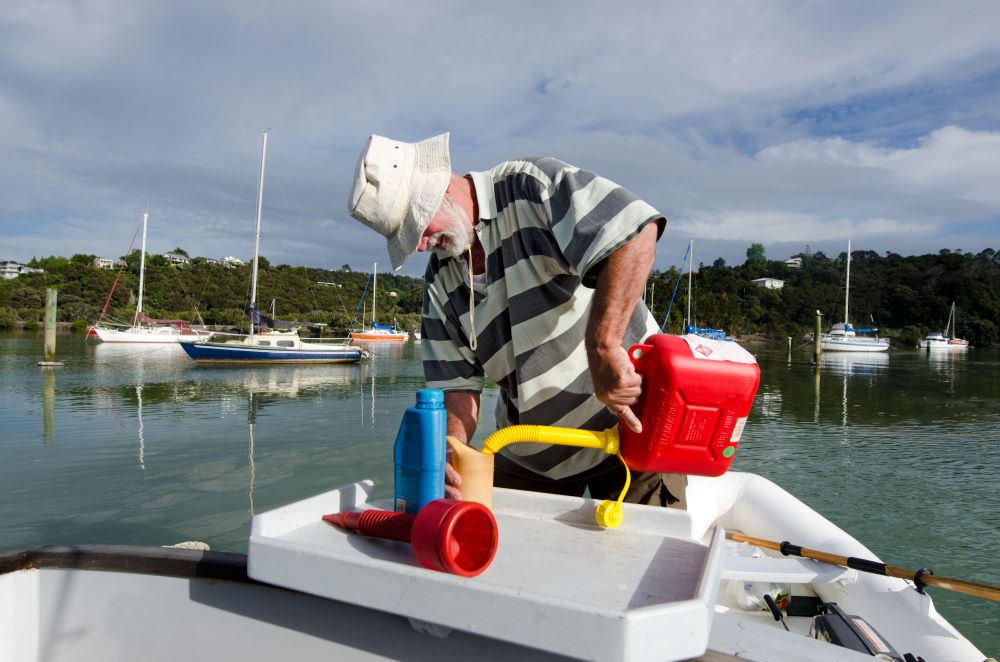
How to Clean a Boat Fuel Tank
If you own a motorboat, cleaning the fuel tank should be part of your regular maintenance routine. Cleaning the fuel tank is also recommended before putting your boat in storage for an extended period of time (e.g., over the winter).
A fuel tank contaminated with dirt or debris can seriously damage your boat’s propulsion system. Fortunately, there are a few simple steps you can take to clean your fuel tank and prevent these problems from occurring.
In this article, find out how to clean a boat fuel tank, why it’s so important and what equipment is needed.
The importance of regular cleaning
Gasoline and other types of boat fuel are mostly mixtures of hydrocarbons. You may be surprised to learn that hydrocarbons are organic compounds that can provide a good environment for bacteria and fungi to grow.
The fuel storage conditions on boats are actually particularly favourable for microorganisms:
- Access to carbon, their main source of food
- Access to water, which they need to grow
- Access to oxygen, which they need to breathe
- Suitable temperatures
When there are significant amounts of bacteria and fungi in the fuel tank, they will accumulate at the bottom and form gelatinous deposits known as sludge. Sludge can easily get into the fuel lines and clog the filter, affecting the engine’s fuel supply and risking power loss.
In extreme cases, residue in the fuel system can permanently damage the injection pump and injectors, causing the engine to shut down.
Preventing this kind of damage is a good reason to keep on top of your fuel tank maintenance!
Equipment needed to clean the fuel tank
You don’t want to be interrupted halfway through cleaning your boat fuel tank because you’re missing a piece of equipment or a product! Here is a list of important items to gather before getting started:
- Protective gloves
- Safety glasses
- A protective mask
- A siphon pump
- Containers with enough volume to hold the fuel and water involved in the cleaning process
- Alcohol or detergent to clean the tank
- A pressure washer
- A window squeegee
- Paper towel
- A waterproof endoscopic camera
Procedure for cleaning a boat fuel tank
1 – Make sure your workspace is safe
Marine fuel and its fumes present several types of hazards. They are toxic and can easily combust and even explode. That’s why it’s important to make sure your workspace is safe before cleaning your fuel tank:
- Make sure you’re working in a well-ventilated area
- Avoid direct contact with the fuel wherever possible
- Be careful not to smoke near the tank or use tools or equipment that could produce sparks
2 – Empty the fuel tank
Some boat fuel tanks are equipped with a drain valve. These are easy to empty—simply place an empty container under the valve and open it to collect the fuel.
If your tank doesn’t have a drain valve, you should be able to insert a siphon pump to suction the fuel and sludge into containers.
3 – Disconnect and drain the lines connecting the fuel tank to the engine
Disconnecting and draining the engine’s fuel lines can prevent problems such as:
- Spilling fuel and water in your workspace
- Water and cleaning products getting into the engine
- Dirt and debris getting trapped in the lines
4 – Remove the old fuel filter
Your old fuel filter is most likely full of dirt and debris, so remove it from the engine. Once your fuel tank is clean, you can replace it with a new one.
5 – Clean the inside of the tank
If your tank is equipped with an access hatch, this step will be much less difficult and time consuming. However, you can still clean the inside of your fuel tank without one.
Tank with an access hatch
Open the access hatch and remove any deposits of sludge from the bottom of the tank with cloths or paper towel. Use a pressure washer to clean the sides of the tank. Then, suction the water out of the tank with a siphon pump.
Pour alcohol or concentrated detergent diluted with water into the tank and let it stand for a few hours before suctioning the liquid out with the pump.
Rinse well with fresh water and let the tank dry.
Tank without an access hatch
Insert absorbent cloths into the fuel gauge mounting hole using a flexible metal rod and try to eliminate as much of the sludge as possible. If you have an endoscopic camera, you can use it to see the inside of the tank and clean it more effectively.
Then, fill the tank with alcohol or diluted detergent and let it stand for a few hours before suctioning it out with a siphon pump.
Use a pressure washer to clean the inside of the tank. Suction out the water and repeat the process until the tank is completely clean.
Let the tank dry and then put it back in place.
Cleaning your fuel tank is easy with the right method
If you follow the steps presented in this guide, cleaning your fuel tank will be a breeze! Regular cleaning will improve the performance of your outboard or inboard engine and prevent mechanical problems related to debris build-up in the fuel system. Remember to do it at least once a year to reap the benefits.
We suggest cleaning the fuel tank every fall before putting your boat in storage so that it will be ready to use next season.
If you want to be even more prepared to hit the water next spring, get your pleasure craft operator card this fall if you don’t already have it. By law, all pleasure craft operators must have their license on them while boating on Canadian waters. Take our Canadian boating safety course today so that you’ll be ready to go next year!

